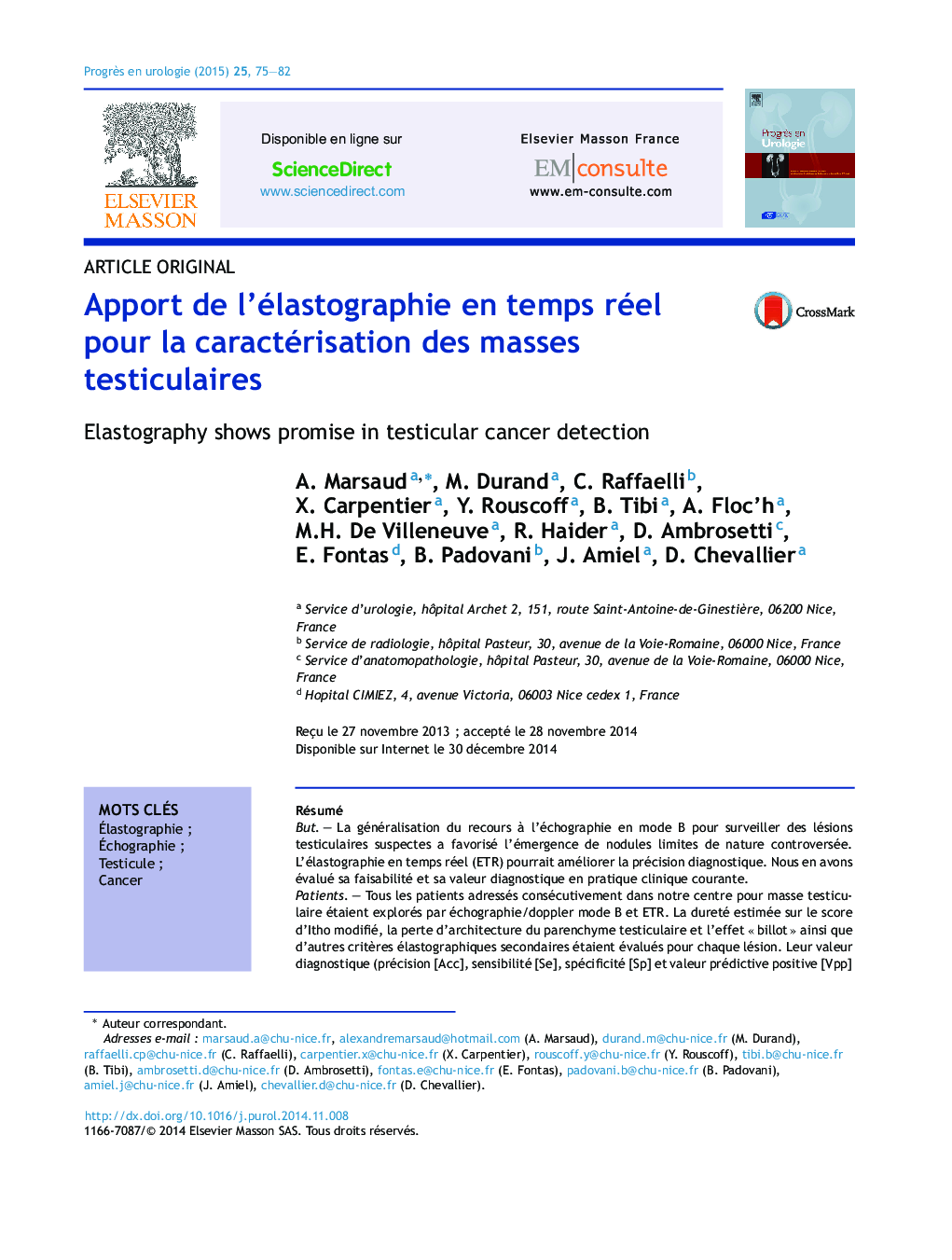| کد مقاله | کد نشریه | سال انتشار | مقاله انگلیسی | نسخه تمام متن |
|---|---|---|---|---|
| 3826442 | 1246882 | 2015 | 8 صفحه PDF | دانلود رایگان |

RésuméButLa généralisation du recours à l’échographie en mode B pour surveiller des lésions testiculaires suspectes a favorisé l’émergence de nodules limites de nature controversée. L’élastographie en temps réel (ETR) pourrait améliorer la précision diagnostique. Nous en avons évalué sa faisabilité et sa valeur diagnostique en pratique clinique courante.PatientsTous les patients adressés consécutivement dans notre centre pour masse testiculaire étaient explorés par échographie/doppler mode B et ETR. La dureté estimée sur le score d’Itho modifié, la perte d’architecture du parenchyme testiculaire et l’effet « billot » ainsi que d’autres critères élastographiques secondaires étaient évalués pour chaque lésion. Leur valeur diagnostique (précision [Acc], sensibilité [Se], spécificité [Sp] et valeur prédictive positive [Vpp] et négative [Vpn]) était appréciée en utilisant les résultats histologiques définitifs des tumeurs traitées par orchidectomie.RésultatsAu total, 34 lésions testiculaires étaient analysées, entre mars 2008 et octobre 2011, chez 30 patients, correspondant à 26 (76 %) tumeurs malignes et 8 (24 %) bénignes (4 hématomes, 3 orchites et 1 ischémie). Les sensibilité, spécificité, valeur prédictive positive, valeur prédictive négative et précision diagnostique étaient respectivement de 82,3 %, 96,2 %, 37,5 %, 83 % et 75 % pour la dureté élastographique (p = 0,03), de 88,2 %, 92,3 %, 75 %, 92,3 % et 75 % pour la perte architecturale (p = 0,01), et de 85,3 %, 84,6 %, 87,5 %, 95,6 % et 63,6 % pour l’effet « billot » (p < 0,01).ConclusionL’ETR pourrait contribuer à caractériser des nodules testiculaires limites avec des critères diagnostiques prometteurs. Des analyses complémentaires prospectives contrôlées sont nécessaires pour valider ces résultats.Niveau de preuve3.
SummaryPurposeElastography is a novel imaging technology that shows promise in the identification of anatomic structures. The widespread use of ultrasound for screening testicular tumors in patients with cancer risk factors highlights unclassified testicular micronodules. We investigated the ability of elastography to accurately diagnose testicular nodules.MaterialPatients with clinical testicular nodules were assigned to undergo elastography in a prospective study. The imaging was carried out by a single radiologist using a static elastography unit with a 9–14 MHz frequency linear transducer, to identify hardness score, loss of architecture of testicular parenchyma, and surrounding effect. When orchidectomy was required, the corresponding specimens were subjected to hematoxylin and eosin staining for histologic correlation.ResultsWe imaged 34 testicular lesions: 26/34 (76%) malignant tumors and 8/34 (24%) non-tumor lesion including 4 hematomas, 3 orchitis and 1 ischemia. Se, Sp, PPV and NPV of hardness in elastography in differentiating between malignant and benign tissue was found to be 96.2%, 37.5%, 83%, and 75%, respectively. Further, for recognizing cancer, the loss of architecture of the testicular parenchyma detecting in elastography was 92.3%, 75%, 92.3%, and 75%, respectively, and the surrounding effect was 84.6%, 87.5%, 95.6% and 63.6%, respectively.ConclusionElastography may be a promising tool at diagnosing testicular tumor when the loss of architecture and the surrounding effect were present. Further studies are needed to evaluate whether the utility of elastography is worth pursuing to identify of unclassified testicular micronodules.Level of evidence3.
Journal: Progrès en Urologie - Volume 25, Issue 2, February 2015, Pages 75–82